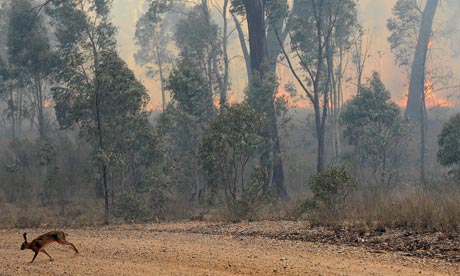
A rabbit flees a bushfire near the town of Rylstone, northwest of Sydney, on November 22, 2009. Photograph: Torsten Blackwood/AFP/Getty Images
A rabbit flees a bushfire near the town of Rylstone, northwest of Sydney, on November 22, 2009. Photograph: Torsten Blackwood/AFP/Getty Images
Australia's deeply troubled ecology demands fresh thinking
The challenge is to stabilise ecosystems, control feral animal populations, curb massive fires, and break the 'grass-fire cycle'
Australia has a deeply troubled ecology and current land management approaches are failing. The challenge is to stabilise ecosystems sent out of whack by a perfect storm of factors, starting with Aboriginal colonisation around 40,000 years ago that was coincident with the mass extinction of a diversity of large animals. What followed was a sustained tradition of Aboriginal landscape burning that ecosystems adjusted to but which European settlers have unwittingly disrupted.
Europeans found a continent primed for large grazing and introduced a variety of useful large herbivores (horses, donkeys, pigs, cattle, goats, sheep, camels,) which become feral or that were intentionally set wild (rabbit, foxes, deer). There were few land predators to control these animals, and the two largest were a threat to livestock (Tasmanian tiger and Australian wolf or dingo). The Tasmanian tiger was driven extinct by the 1930s and dingos have been subjected to a sustained campaign of culling by shooting and poisoning.
A number of flammable grasses have been introduced to Australian rangelands, in some cases in the mistaken belief that they would benefit livestock. This has initiated a vicious circle of uncontrolled fires in some outback landscapes. For example, the giant grass introduced from west Africa (gamba grass) dramatically increases the destructive power of fires killing eucalypt plants, renowned for their fire tolerance in the northern savannas. It is claimed by some scientists that this grass could cover 5% of the continent if left uncontrolled. Already we are seeing massive savanna fires – last year after the soaking rains, at least 5% of the continent was burnt in massive fires, one the size of Tasmania.
All these facts demand we apply some fresh thinking to managing Australian landscapes, which must include control of feral animal populations, curbing massive fires, and breaking the "grass-fire cycle". Current approaches aren't working well clearly. But options that could work are challenging, more often that not because of cultural and social factors as much as biological reasons. Australians have some double standards when it comes to feral animals: lethal control of horses in a hugely sensitive issue but we are more sanguine about the current mass cull of camels in the outback.
Australia needs effective top predators to control the ferals that periodically degrade ecosystems. The options are all problematic. We could allow dingo populations to form packs, but this has obvious downside for livestock and possibly humans. We could introduce komodo dragons to replace the extinct giant lizards, as suggested by Tim Flannery. I think a better option is to employ Aborigines to hunt animals.
It is a bitter irony that the vast Aboriginal lands of the outback that were handed back to Aboriginal groups are a shadow of their former selves because of the ecological disruptions described above. Aborigines have been activity encouraged to settle in townships and give up their nomad lifestyles, entering into a poverty trap of which there are few escape routes - one is land management. Epidemiological studies have shown Aboriginal engagement with land management is a powerful health intervention that can contribute to reversing the appalling health statistics of our indigenous people.
But to tackle some issues, like gamba grass, we may need to consider introducing more large herbivores - such as elephants. I do not advocacate releasing a barge load of African animals, rather I can imagine using these creatures as powerful ecological tools that are possibly less harmful that the conventional approaches of herbicides and mechanical disturbance. They could be radio-collared and sterilised to make sure they never become feral.
Obviously we need to proceed carefully in managing the Australian landscape, but a do-nothing attitude is no longer an option.
Australians are in fact already embarking on some very large-scale management interventions. For example, Aborigines are being employed to undertake fire management in western Arnhem Land to curb greenhouse gas emissions from fires.
Alternatives to current approaches are all fraught and only honest debate and evidence-based analysis will lead to sustainable management – I suspect there are solutions out there but they may be difficult to accept.
• David Bowman is professor of environmental change biology at the University of Tasmania
Source:
David Bowman
guardian.co.uk, Wednesday 1 February 2012 18.00 GMT
Australia's deeply troubled ecology demands fresh thinking | David Bowman | Environment | guardian.co.uk:
No comments:
Post a Comment